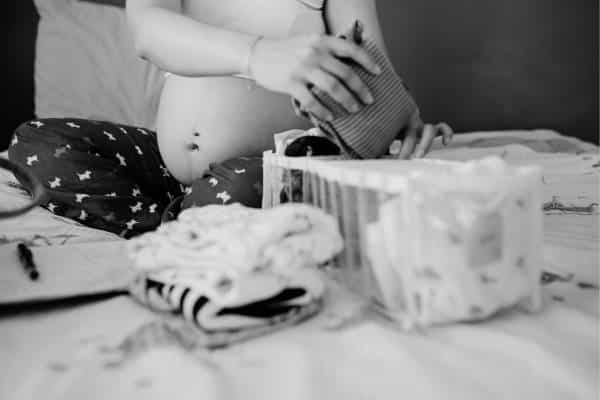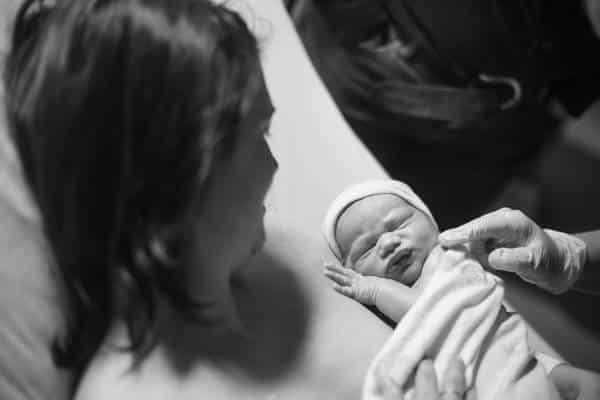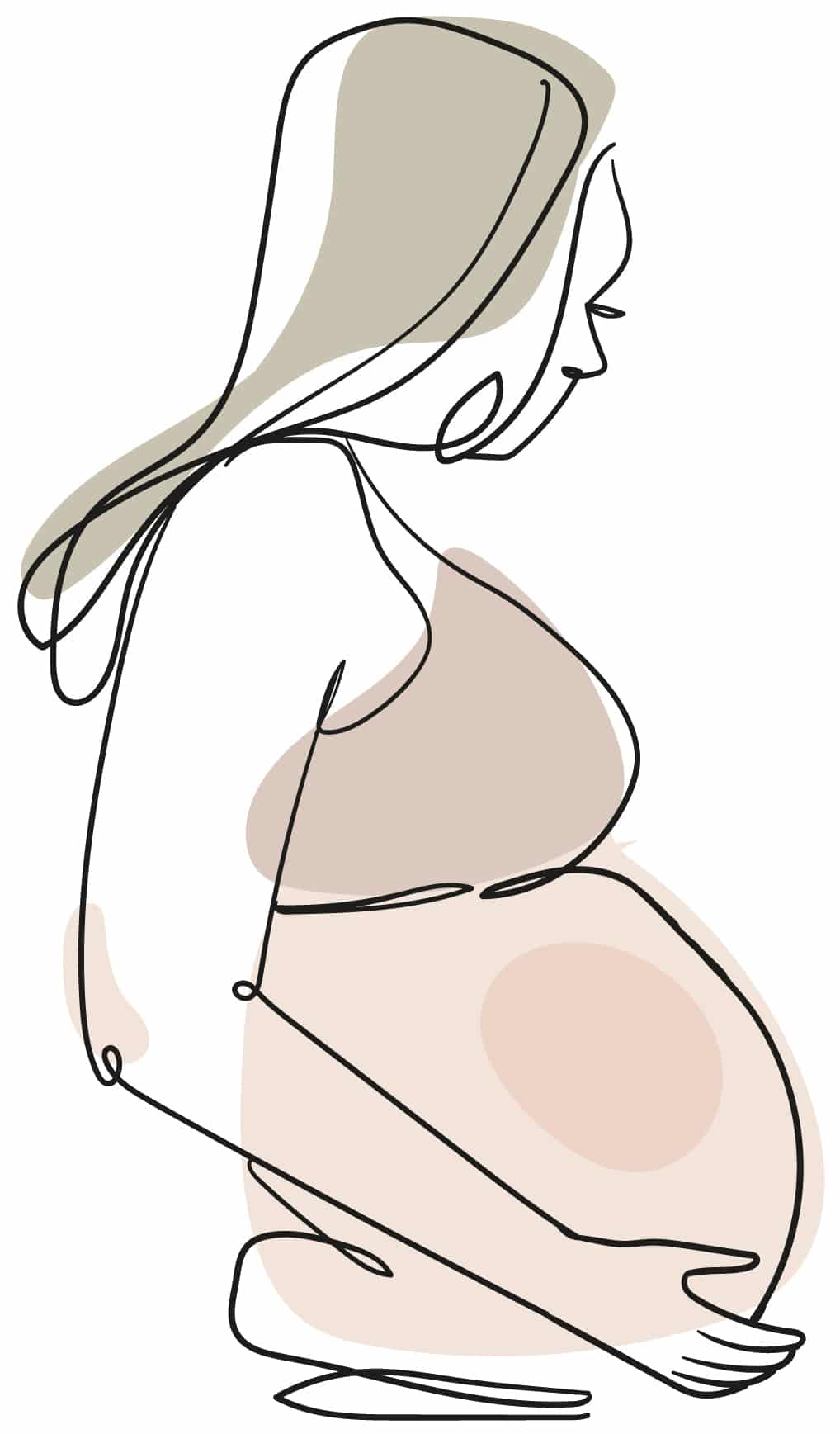Preparing for childbirth: osteopathy for optimal preparation
Preparing for childbirth is essential for women who pregnant couplesThe aim is to provide them with the knowledge and preparation necessary to face the last phase of pregnancy. Traditionally, this type of preparation is carried out.
It is recommended that pregnant women go to osteopathic sessions during the last trimester of pregnancy, even if you are scheduled to have a caesarean section, for final checks before delivery.
During these sessions, specialists such as Marina and Nicolas make sure that the bone structures of the patient's bones are in good condition. the pelvis have adequate mobilityin both macro- and micro-mobility. In addition, eassess the integrity of the fasciae, pelvic ligaments and the health of the lower abdominal organs (bladder, uterus and rectum), as well as that of the muscles involved.
During childbirth, the pelvis performs two essential movements known as nutation and counter-nutationThe baby's movements are facilitated through the upper and lower straits of the pelvis. Ensuring that these natural movements occur without restriction is essential for a smooth birth.
The flexibility of the spine and ribs is vital for women to deal effectively with the demands of women's contractions and adopt different positions during the "marathon" of childbirth.
Don't skip the birth preparation visit. This appointment is invaluable to ensure that your body is in the best possible condition for birth, optimising all its capabilities.
How does osteopathy help to prepare for childbirth?



Specific osteopathic strategies
In preparation for childbirth, the osteopathic strategies focus on optimising the body's functionality of the mother to facilitate as smooth and natural a birth as possible. Here are some specific techniques and approaches used:
Pelvic alignment and mobility
- Pelvic adjustmentsEnsuring optimal alignment of the pelvis to maximise the space available for the baby to pass through.
- Sacroiliac mobilitywork on the mobility of the sacroiliac joints to facilitate the nutation and counter-nutation movements necessary during childbirth.
Muscle and fascial tension management
- Myofascial releasetechniques aimed at releasing tension in the fascial tissues, improving flexibility and reducing pain.
- Relaxation of the pelvic floor musclesteaching mothers techniques to relax and control their children's pelvic floor musculatureThe childbirth process is crucial during the stages of childbirth.
Optimisation of organ function
- Improved circulationtechniques that promote better blood and lymphatic circulation, essential for the health of the baby and the mother.
- Digestion supportAdjustments that relieve pressure on the digestive organs, reducing discomfort such as heartburn and constipation.
Breathing and relaxation techniques
- Breathing exercises: teaching mothers breathing techniques and relaxation to manage pain and stress during childbirth.
- Positive visualisation: visualisation techniques to mentally prepare the mother, reducing fear and anxiety.
Practical recommendations
Specialised consultation
Looking for an osteopath with experience in antenatal and postnatal care.
Regular practice
Integrate learned exercises and techniques into your daily routines to maintain flexibility and relaxation.
To learn more about these strategies and to find qualified professionals, you can visit sites such as the Spanish College of Osteopaths and the Spanish Federation of Osteopathswhere they offer directories of specialists and educational resources on prenatal osteopathy.
Mental and emotional preparation
| In addition to physical preparation, the mental and emotional preparation is essential to face childbirth with confidence and serenity. Mind and body are intrinsically connectedand a positive attitude can significantly influence the childbirth experience. | ||
Relaxation and mindfulness techniques |
Positive visualisation |
Preparing for the postpartum period |
| MeditationMeditation practices can help to focus the mind, reduce stress and anxiety, and foster a state of calm. MindfulnessMindfulness teaches you to be present in the moment, which is especially useful during childbirth to manage pain and emotions. | Guided imagesactively imagining a positive and peaceful birth can mentally prepare the mother for the experience, reducing fears and anxieties. Positive internal dialogueThe following is crucial to maintaining a constructive and motivating internal dialogue building trust in the ability to cope with childbirth. | Realistic expectationsUnderstanding that the postpartum period is a time of adjustment and recovery can help manage emotions and challenges that may arise. Personal care planDeveloping a plan to care for your emotional and physical well-being after childbirth is essential for a healthy recovery. |
| In addition to physical preparation, the mental and emotional preparation is essential to face childbirth with confidence and serenity. Mind and body are intrinsically connectedand a positive attitude can significantly influence the childbirth experience. | ||
Relaxation and mindfulness techniques |
||
| MeditationMeditation practices can help to focus the mind, reduce stress and anxiety, and foster a state of calm. | ||
| MindfulnessMindfulness teaches you to be present in the moment, which is especially useful during childbirth to manage pain and emotions. | ||
Positive visualisation |
||
| Guided imagesactively imagining a positive and peaceful birth can mentally prepare the mother for the experience, reducing fears and anxieties. | ||
| Positive internal dialogueThe following is crucial to maintaining a constructive and motivating internal dialogue building trust in the ability to cope with childbirth. | ||
Preparing for the postpartum period |
||
| Realistic expectationsUnderstanding that the postpartum period is a time of adjustment and recovery can help manage emotions and challenges that may arise. | ||
| Personal care planDeveloping a plan to care for your emotional and physical well-being after childbirth is essential for a healthy recovery. | ||
Importance of childbirth preparation courses
Childbirth preparation courses are essential to provide expectant parents with the tools and knowledge they need to face the birth process with confidence and security. These courses range from breathing and relaxation techniques to practical and emotional aspects of childbirth, helping to reduce anxiety and promote a positive birth experience. For more details, it is advisable to visit specialised sites on this topic.
Types of childbirth classes available
There are different types of childbirth preparation courses, each with its specific characteristics and benefits:
- Face-to-face classes in specialised centresThese classes are usually taught by health professionals, such as midwives or childbirth specialists, and offer direct, hands-on experience. Benefits include personal interaction and the ability to resolve questions on the spot.
- Online childbirth preparation coursesThese courses provide the flexibility to learn at your own pace and from the comfort of your own home. They are ideal for those who have complicated schedules or prefer a distance learning modality.
- Customised programmesSome centres and professionals offer programmes tailored to the individual needs of each couple, which may include one-to-one sessions and personalised birth preparation plans.
Each type of course has its advantages, and the choice will depend on your personal needs, preferences and circumstances. It is important to research and consider which option best aligns with your expectations and lifestyle. For more information and guidance, you can consult authoritative websites in the field of health and pregnancy, such as the National Institute of Health o the World Health Organisation.

Particular cases
Sharing testimonies and experiences The real-life stories about birth preparation and childbirth itself is a valuable tool for mothers-to-be. These stories can provide insights, advice and comfort, offering a broader view of what to expect and how others have coped with similar challenges.
Learning
Shared experiences can teach about different aspects of childbirth, from pain management techniques to how to communicate effectively with the health care team.
Empathy and support
Knowing that others have gone through similar experiences can offer great comfort and reduce feelings of isolation.
Diversity of perspectives
Recommended resources
- Childbirth is OursThe association offers information and support, and where you can find personal stories about childbirth (Childbirth is Ours).
- Midwives and youa portal with resources, information and a blog where professionals and mothers share their experiences (Midwives and You).
Including this section in your content can foster the building of a supportive community, encouraging mothers-to-be to seek out and share stories that enrich their own preparation for childbirth.
Reliable sources of information
- Professional Associations: organisations such as the Federation of Professional Associations and Midwives of Spain offer educational resources, guidelines and evidence-based recommendations for expectant mothers.
- Maternal health centres: Many centres and specialised clinics offer childbirth preparation programmes, workshops and information sessions. Check out the resources available in your local area.
Personalised professional support
Midwives and osteopathic specialists: consider scheduling regular appointments with pregnancy and childbirth professionals for personalised advice and support.
Checklists and guides
- Birth planning documents: tools such as checklists and delivery plan templates can help you organise your preferences and communicate them effectively to your health care team.
- Federation of Spanish Midwives' AssociationsThe Birth Preparedness Centre: provides information, resources and access to skilled birth preparedness professionals.
- Spanish Association of OsteopathyFind professionals specialised in osteopathy for pregnant women.



When should you start preparing for childbirth?
Childbirth preparation is an essential component of pregnancy that helps expectant mothers and couples face the birth process with knowledge, confidence and peace of mind. Generally, it is recommended that starting birth preparation during the second trimester of pregnancyat around 20 weeks gestation. This time is usually ideal because most mothers have already overcome the most common complications of the first trimester and tend to feel physically more comfortable.
Importance of early preparation
- Body adaptationStarting early allows your body to gradually adapt to the exercises and practices recommended for childbirth.
- Information and knowledgeYou have more time to learn about the birth process, explore your birth options and make informed decisions about your birth plan.
- Stress and anxiety managementEarly preparation can help you manage any anxieties or fears you may have about childbirth, allowing you to address these emotions proactively.
- EducationTaking the time to learn about the birth process, pain management options and common medical interventions can help you make informed decisions.
- Physical strengtheningParticipating in activities such as prenatal yoga or pilates can strengthen muscles essential for childbirth, as well as improve breathing and relaxation.
- Emotional connectionEarly initiation offers the opportunity to develop a deeper connection with your baby and your partner as you share this stage of preparation together.
Recommended activities to prepare for childbirth
- Childbirth preparation classesThese classes offer information on the birthing process, breathing techniques, pain management options and relaxation strategies.
- Moderate physical exercisepractices such as prenatal yoga, pilates and walking can improve your fitness and prepare your body for childbirth.
- Antenatal consultationsMaintain regular communication with your health care provider to monitor your baby's and your own health, and discuss any concerns or questions you have about the birth.
Preparing for childbirth is not just a matter of attending classes or reading about childbirth; it is a holistic process that involves the mind, body and emotions. Taking the time to prepare properly can make a big difference to your birth experience.
Resources for preparation
- Childbirth preparation coursesMany hospitals and health centres offer courses ranging from breathing and relaxation techniques to newborn care.
- Professional adviceconsulting a specialist, such as a midwife or obstetrician, can provide personalised guidance and answer your specific questions.
Starting your childbirth preparation early will allow you to face this time with greater confidence and peace of mind, making it a more positive experience for both you and your baby.



How do I know my body is preparing for childbirth?
Physical signs
- Descent of the babyAs labour approaches, you may notice that your baby "latches on", moving down into your pelvis. This can happen a few weeks or days before delivery and often results in easier breathing and less pressure on the stomach.
- Braxton Hicks contractionsThese "practice contractions" can become more frequent and stronger as labour approaches, helping to prepare your uterus for actual labour.
- Expulsion of the mucus plugYou may notice a thick, jelly-like discharge, sometimes with streaks of blood, known as the mucus plug. Its expulsion indicates that the cervix is beginning to dilate in preparation for labour.
Emotional and behavioural changes
- NestNesting instinct: It is common to experience an urge to organise and prepare everything for the baby's arrival, known as the nesting instinct.
- Mood swingsYou may experience emotional fluctuations, from excitement and energy to anxiety and introspection.
Physiological changes
- Dilatation and effacement of the cervixDuring the weeks leading up to delivery, the cervix may begin to dilate (open) and efface (thin), preparing for the passage of the baby.
- Membrane rupturewater break: commonly known as "water breaking", this is when the amniotic sac ruptures, releasing the amniotic fluid. This can happen before or during labour.
What are the 4 stages of childbirth?
The birth process is generally divided into four main stages, each with specific characteristics and durations. Understanding these stages can help you better prepare for what's ahead and know what to expect.
Dilatation
- Latent phaseThe onset of labour is characterised by irregular contractions that begin to dilate and efface the cervix. This phase can last for several days, especially in first timers.
- Active phaseDilatation progresses from 3 to 4 cm to approximately 7 cm. Contractions become more regular, intense and frequent. It is common for the amniotic sac to rupture during this phase.
- TransitionThe final part of the first stage, where dilatation progresses from 7 to 10 cm. Contractions are intense and very frequent, marking the preparation to start pushing.
Expulsion
- Beginning of the pushOnce the cervix is fully dilated, the pushing phase begins, where the mother is encouraged to push with each contraction to help the baby move down the birth canal.
- Birth of the babyThis stage culminates with the birth of the baby. The length of this phase can vary widely, especially among first-time women and those who have given birth before.
Lighting
Immediate postpartum recovery
How long does it take to dilate from 7 to 10 cm?
Factors influencing duration
- First pregnancyIn women giving birth for the first time, this phase can last 2 to 3 hours on average, although there is wide variability.
- Subsequent pregnanciesIn women who have given birth before, this phase tends to be shorter, lasting 1 to 2 hours or even less.
Characteristics of this phase
- Contractionsare particularly intense and frequent, occurring every 2 to 3 minutes and lasting about 60 to 90 seconds each.
- IntensityIt is common to experience intense sensations of pressure and the urge to push, although it is recommended to wait until you are fully dilated to begin effective pushing.
Tips for managing this phase
- Relaxation and breathing techniquesuse techniques learned in childbirth preparation courses to manage pain and remain calm.
- Continuous supportThe presence of a doula, partner, midwife or loved one to provide emotional and physical support can be invaluable.
- Comfortable positionsChanging positions to relieve pain and facilitate dilatation, such as walking, rocking, hot showers or soaking in a bathtub.
It is important to remember that every birth is unique and that these durations are averages, not set rules. Maintaining open communication with your health care team and trusting your body are key to navigating this stage of labour with confidence.
How do I know if I am about to give birth?
Key signals
- Regular and progressive contractionsUnlike Braxton Hicks contractions, which are irregular and usually disappear with movement or change of position, labour contractions are regular, become more intense and frequent over time, and do not diminish with change of activity.
- Membrane ruptureThe amniotic sac, commonly known as the "water breaking", is when the amniotic sac ruptures, releasing the amniotic fluid. This can happen in one big gush or in a steady trickle. Not all women experience rupture of membranes before the onset of contractions.
- Expulsion of the mucus plugYou may notice the expulsion of the mucus plug, which can be a thick, jelly-like discharge, sometimes mixed with blood, known as "implantation bleeding".
- Increased pelvic pressureas the baby moves down into the pelvis, you may feel increasing pressure in the pelvic area and perhaps the sensation that the baby is "pushing down".
- Changes in energySome women experience an increase in energy, while others may feel more tired or anxious.
- Dilatation of the cervixAlthough this sign is usually checked by a health professional during examinations, dilation and effacement of the cervix are clear indicators that the body is preparing for labour.
Recommendations
If you think you are about to give birth, especially if you are experiencing regular, strong contractions or if you have noticed your membranes rupturing, it is important to contact your doctor or midwife. They will be able to give you guidance on when to go to the birthing centre or hospital and provide you with the support you need at this stage.
Remember that every birth experience is unique, and not all women experience all of these signs. Keeping open communication with your health care team and trusting your intuition are key during this exciting time.
How do you know if a woman is dilating?
The dilatation is the process by which the cervix opens and thins to allow the passage of the baby during labour. This is a key indicator of the progress of labour. However, it is not always obvious to the woman without an examination by a health professional. Here are some signs and situations that may indicate that dilation is occurring:
Associated signs and symptoms
- Intensification of contractionsas the cervix dilates, contractions tend to become more intense, regular and frequent. An effective labour contraction usually lasts about 30 to 70 seconds and occurs every 5 to 10 minutes.
- Changes in vaginal dischargeThe expulsion of the mucus plug or an increase in vaginal discharge may be indicative of changes in the cervix, including dilatation.
- Feeling of pressureas the baby descends and the cervix dilates, you may feel increasing pressure in the pelvic and rectal area.
- Light bleedingImplantation bleeding, known as "implantation bleeding", can occur as the cervix dilates and prepares for childbirth.
Assessment by a professional
- Vaginal examinationThe most accurate way to determine dilatation is through a vaginal examination by a health professional. During the examination, the opening of the cervix will be assessed in centimetres.
- Monitoring signs of progressThe health professionals will also observe other signs of progress in labour, such as the effacement (thinning) of the cervix and the baby's descent through the birth canal.
It is important to remember that dilation is only one part of the labour process and that the speed of dilation can vary widely between women and between different births of the same woman. Some women may dilate slowly for days before active labour, while others may experience rapid dilation within a few hours.
If you think you are in labour or have concerns about dilation, it is crucial to communicate with your medical team for appropriate guidance and support.
Questions on childbirth preparation
Childbirth preparation is an essential component of pregnancy that helps expectant mothers and couples face the birth process with knowledge, confidence and peace of mind.
Generally, it is recommended to start preparing for birth during the second trimester of pregnancy, around 20 weeks gestation.
This is often an ideal time because most mothers are over the common complications of the first trimester and tend to feel physically more comfortable.
Importance of early preparation
- Body adaptation: starting early allows your body to gradually adapt to the exercises and practices recommended for childbirth.
- Information and knowledge: you have more time to learn about the birth process, explore your birth options and make informed decisions about your birth plan.
- Stress and anxiety management: early preparation can help you manage any anxieties or fears you may have about childbirth, allowing you to address these emotions proactively.
Recommended activities
- Childbirth preparation classes: these classes offer information on the birthing process, breathing techniques, pain management options and relaxation strategies.
- Moderate physical exercise: practices such as prenatal yoga, pilates and walking can improve your fitness and prepare your body for childbirth.
- Prenatal consultations: maintain regular communication with your health care provider to monitor your baby's and your own health, and discuss any concerns or questions you have about the birth.
Preparing for childbirth is not just a matter of attending classes or reading about childbirth; it is a holistic process involving the mind, body and emotions.
Taking the time to prepare properly can make a big difference to your birth experience.
Starting childbirth preparation is an important decision for mothers-to-be and their families.
Ideally, it is recommended to start this process in the second trimester of pregnancy, around week 20.
This period allows the mother to adapt to the physical and emotional changes of pregnancy, while gradually and unhurriedly getting informed and prepared for the birth.
Importance of early preparation
- Education: Taking the time to learn about the birth process, pain management options and common medical interventions can help you make informed decisions.
- Physical strengthening: participating in activities such as prenatal yoga or pilates can strengthen muscles essential for childbirth, as well as improve breathing and relaxation.
- Emotional connection: starting early offers the opportunity to develop a deeper connection with your baby and your partner as you share this stage of preparation together.
Resources for preparation
- Childbirth preparation courses: Many hospitals and health centres offer courses ranging from breathing and relaxation techniques to newborn care.
- Professional advice: consulting a specialist, such as a midwife or obstetrician, can provide personalised guidance and answer your specific questions.
Starting your childbirth preparation early will allow you to face this time with greater confidence and peace of mind, making it a more positive experience for both you and your baby.
Recognising the signs that your body is preparing for labour is crucial to understanding the process and feeling more confident as the big moment approaches.
Here are some indicators:
Physical signs
- Descent of the baby: As labour approaches, you may notice that your baby "latches on", moving down into your pelvis. This can happen a few weeks or days before delivery and often results in easier breathing and less pressure on your stomach.
- Braxton Hicks contractions: these "practice contractions" can become more frequent and stronger as labour approaches, helping to prepare your uterus for actual labour.
- Expulsion of the mucus plug: you may notice a thick, jelly-like discharge, sometimes with streaks of blood, known as the mucus plug. Its expulsion indicates that the cervix is beginning to dilate in preparation for labour.
- Emotional and behavioural changes
Nest: it is common to experience an urge to organise and prepare everything for the baby's arrival, known as the nesting instinct. - Mood swings: you may experience emotional fluctuations, from excitement and energy to anxiety and introspection.
- Physiological changes
Dilatation and effacement of the cervix: During the weeks leading up to delivery, the cervix may begin to dilate (open) and efface (thin), preparing for the passage of the baby. - Membrane rupture: commonly known as "water breaking", is when the amniotic sac ruptures, releasing the amniotic fluid. This can happen before or during labour.
It is important to maintain regular communication with your health care provider during the last weeks of pregnancy to monitor these and other signs of readiness for birth.
Each woman and each pregnancy is unique, so these signs may vary in intensity and sequence.
The birth process is generally divided into four main stages, each with specific characteristics and durations.
Understanding these stages can help you better prepare for what lies ahead and know what to expect.
- First stage: dilatation
Latent phase: the onset of labour is characterised by irregular contractions that begin to dilate and efface the cervix. This phase can last for several days, especially in first timers.
Active phase: dilatation progresses from 3 to 4 cm to approximately 7 cm. Contractions become more regular, intense and frequent. It is common for the amniotic sac to rupture during this phase.
Transition: is the final part of the first stage, where dilatation progresses from 7 to 10 cm. Contractions are intense and very frequent, marking the preparation to start pushing.
- Second stage: expulsion
Beginning of pushing: Once the cervix is fully dilated, the pushing phase begins, where the mother is encouraged to push with each contraction to help the baby move down the birth canal.
Birth of the baby: this stage culminates with the birth of the baby. The length of this phase can vary widely, especially among first-time women and those who have given birth before.
- Third stage: birth
After the baby is born, the stage of labour begins, where the placenta is delivered. This stage can last from a few minutes to half an hour and is usually less painful, although contractions may continue until the placenta is completely expelled.
- Stage four: immediate postpartum recovery
Although not always mentioned as a stage of labour, the first hours after birth are crucial for the mother's recovery and early bonding with the baby. During this time, the mother's physical recovery, the initiation of breastfeeding and the newborn's well-being are monitored.
Each of these stages is vital to the birth process and can vary significantly from woman to woman. Being informed about what happens at each stage will help you face labour with greater knowledge and peace of mind.
Dilation of 7 to 10 cm, which occurs during the transitional phase of the first stage of labour, is known to be one of the most intense and challenging phases of the birth process.
The duration of this phase can vary significantly from one woman to another and can also differ between different births of the same woman.
Factors influencing duration
- First pregnancy: in women giving birth for the first time, this phase can last 2 to 3 hours on average, although there is wide variability.
- Subsequent pregnancies: In women who have given birth before, this phase tends to be shorter, lasting 1-2 hours or even less.
Characteristics of this phase
- Contractions: are particularly intense and frequent, occurring every 2 to 3 minutes and lasting about 60 to 90 seconds each.
- Intensity: It is common to experience intense sensations of pressure and the urge to push, although it is recommended to wait until you are fully dilated to begin effective pushing.
Tips for managing this phase
- Relaxation and breathing techniques: use techniques learned in childbirth preparation courses to manage pain and remain calm.
- Continuous support: the presence of a doula, partner, midwife or loved one to provide emotional and physical support can be invaluable.
- Comfortable positions: changing position to relieve pain and facilitate dilation, such as walking, rocking, taking a hot shower or soaking in a bathtub.
It is important to remember that each birth is unique and that these durations are averages, not fixed rules.
Open communication with your health care team and trusting your body are key to navigating this stage of labour with confidence.
Being close to giving birth is accompanied by a number of signs and symptoms that indicate that labour is near or has already begun.
Recognising these signs can help you prepare for the moment you head to the hospital or birthing centre.
Key signals
- Regular and progressive contractions: Unlike Braxton Hicks contractions, which are irregular and usually disappear with movement or change of position, labour contractions are regular, become more intense and frequent over time, and do not diminish with change of activity.
- Membrane rupture: commonly known as "water breaking", is when the amniotic sac ruptures, releasing the amniotic fluid. This can happen in one big gush or in a steady trickle. Not all women experience rupture of membranes before the onset of contractions.
- Expulsion of the mucus plug: you may notice the expulsion of the mucus plug, which can be a thick, jelly-like discharge, sometimes mixed with blood, known as "implantation bleeding".
- Increased pelvic pressure: As the baby moves down into the pelvis, you may feel increasing pressure in the pelvic area and perhaps a feeling that the baby is "pushing down".
- Changes in energy: Some women experience increased energy, while others may feel more tired or anxious.
- Dilatation of the cervix: although this sign is usually checked by a health professional during examinations, dilation and effacement of the cervix are clear indicators that the body is preparing for labour.
Recommendations
If you think you are about to give birth, especially if you are experiencing regular, strong contractions or if you have noticed your membranes rupturing, it is important to contact your doctor or midwife. They will be able to give you guidance on when to go to the birthing centre or hospital and provide you with the support you need at this stage.
Remember that every birth experience is unique, and not all women experience all of these signs. Keeping open communication with your health care team and trusting your intuition are key during this exciting time.
Dilation is the process by which the cervix opens and thins to allow the baby to pass through during labour.
This is a key indicator of labour progress. However, it is not always evident to the woman without an examination by a health professional.
Here are some signs and situations that may indicate that dilatation is occurring:
Associated signs and symptoms
- Intensification of contractions: As the cervix dilates, contractions tend to become more intense, regular and frequent. An effective labour contraction usually lasts about 30 to 70 seconds and occurs every 5 to 10 minutes.
- Changes in vaginal discharge: expulsion of the mucus plug or an increase in vaginal discharge may indicate changes in the cervix, including dilatation.
- Feeling of pressure: As the baby descends and the cervix dilates, you may feel increasing pressure in the pelvic and rectal area.
- Light bleeding: known as "implantation bleeding", can occur as the cervix dilates and prepares for delivery.
Assessment by a professional
- Vaginal examination: The most accurate way to determine dilatation is through a vaginal examination by a health professional. During the examination, the opening of the cervix will be assessed in centimetres.
- Monitoring signs of progress: health professionals will also observe other signs of progress in labour, such as the effacement (thinning) of the cervix and the baby's descent through the birth canal.
It is important to remember that dilatation is only one part of the labour process and that the speed of dilatation can vary widely between women and between different births of the same woman.
Some women may dilate slowly for days before active labour, while others may experience rapid dilation within a few hours.
If you think you are in labour or have concerns about dilation, it is crucial to communicate with your medical team for appropriate guidance and support.
In the days leading up to labour, a number of symptoms may occur that indicate that the body is preparing for birth. These include:
- ContractionsThese may become more regular and stronger as you get closer to labour.
- Expulsion of the mucus plugVaginal discharge: An increase in vaginal discharge may be noted, sometimes including a plug of mucus that has sealed the cervix during pregnancy.
- Water breakageAmniotic fluid release may occur in a large gush or a steady trickle.
- InsetThe baby descends into the pelvis, which may make breathing easier but increases pressure on the pelvis and bladder.
- Changes in energySome women experience an increase in energy, while others may feel more tired and anxious.
These signs are indications that labour may be near, but the exact timing can vary widely. It is always advisable to contact your doctor or midwife to confirm whether you are going into labour.
In the childbirth preparation course, it is essential to ask questions that will help you better understand what to expect during labour and how to handle various situations. Some key questions might include:
- Breathing and relaxation techniquesWhat are the most effective techniques for pain management during childbirth?
- Stage of labourHow can I distinguish the different stages of labour and know when to go to the hospital?
- Medical interventionsWhat types of medical interventions might be necessary and how can I prepare for them?
- Delivery planHow can I make sure that my preferences are taken into account during childbirth?
- Postpartum careWhat care will I need after birth and how can I plan for support at home?
Asking these questions can provide clarity and confidence as you approach the birth experience, ensuring that you feel prepared and supported.
The duration of childbirth classes may vary depending on the specific programme and the institution offering it. Generally, courses can last from a few weeks to several months. Each session usually lasts 1-2 hours and may be offered once a week. It is important to ask about the intensity and timing of the classes so that you can organise your schedule accordingly and ensure that you can attend all the important sessions.



